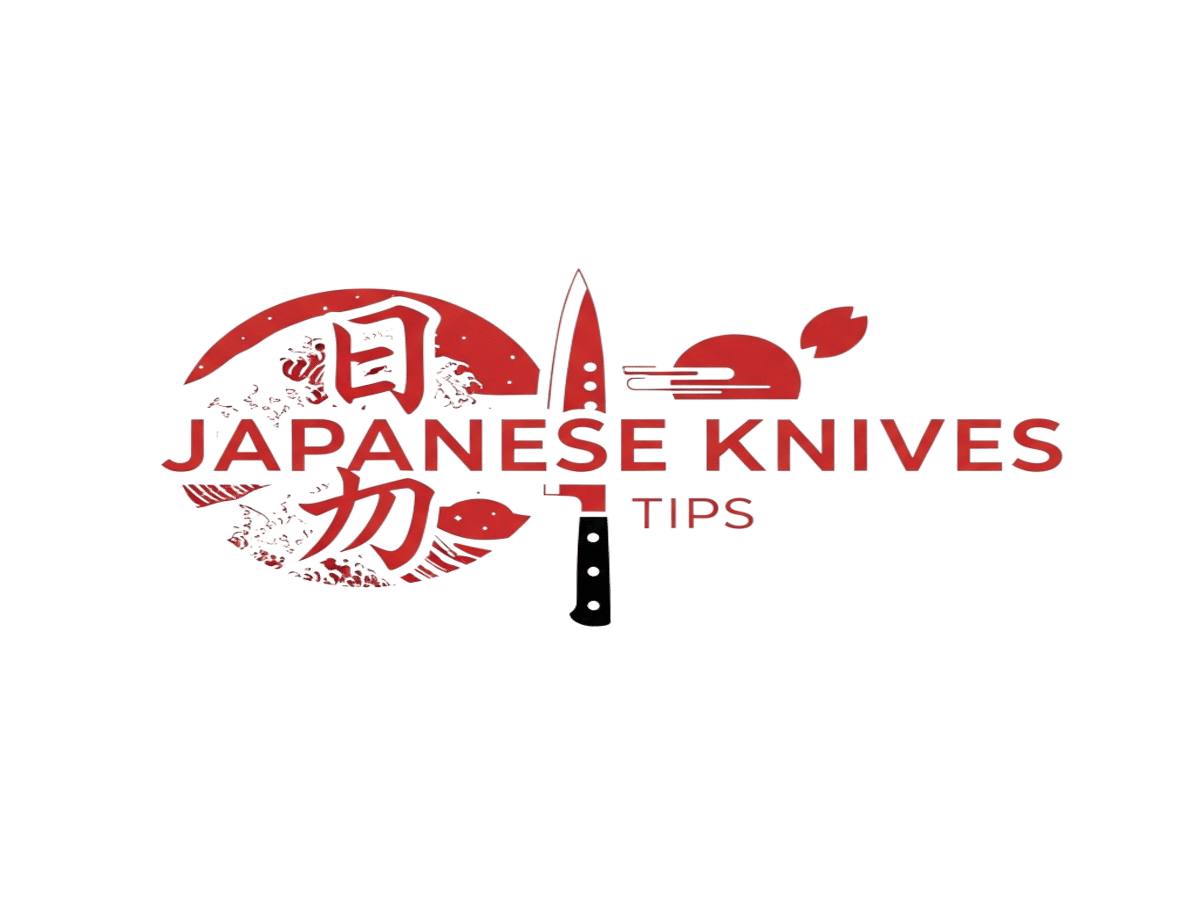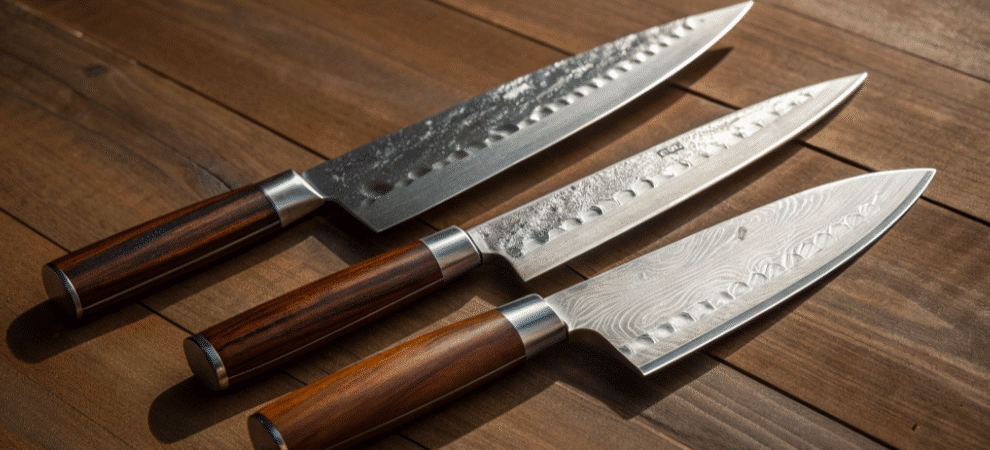When I first picked up a santoku knife, I wasn’t sure what to expect. It’s not your typical chef’s knife—shorter, lighter, and built for quick, clean cuts. The name means “three virtues,” which makes sense because it handles fish, meat, and veggies with ease. Like a chef knife, the santoku is a versatile kitchen tool, suitable for a wide range of tasks from dicing meat to filleting fish. It excels at producing thin, evenly sliced ingredients, making it a great choice for anyone who values precision and efficiency. If you want a knife that’s easy to use and works well for everyday cooking, this one’s worth a look.
- Introduction to Japanese Knives
- What’s a Santoku Knife?
- How Is It Different From a Chef’s Knife?
- Features of Santoku Knives
- Picking the Best Santoku Knives
- Knife Materials
- Using Your Santoku Knife Like a Pro
- Safety Precautions
- Advanced Techniques
- Caring for Your Knife and Cutting Board
- Common Mistakes to Avoid
- Why You’ll Love a Santoku Knife
- Final Tips
- FAQs About Santoku Knives
Introduction to Japanese Knives
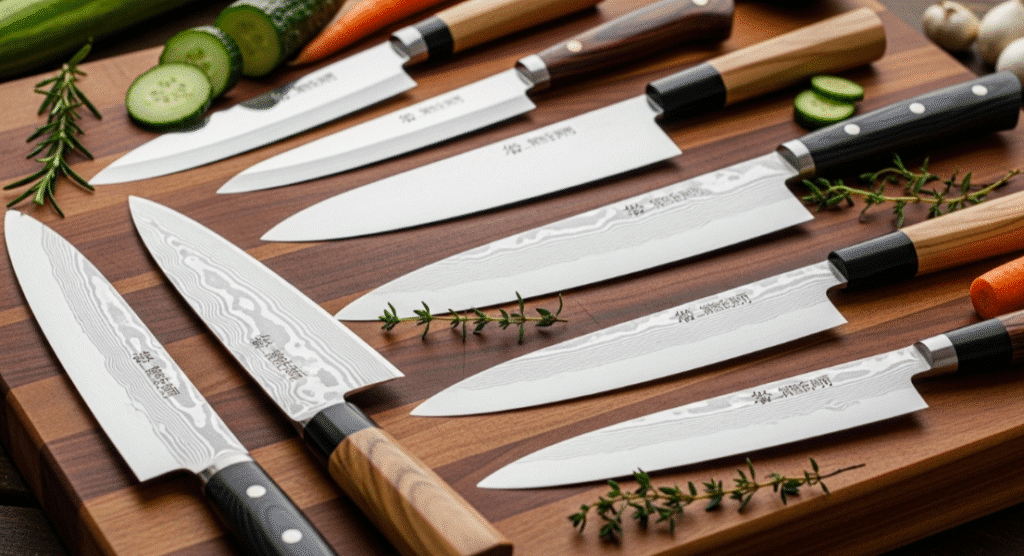
Japanese knives are amazing. Santoku knives too. People love them everywhere. Why? They’re super sharp. They cut with precision. You can’t beat that. Japan makes them right. They focus on quality. They focus on detail. These knives handle everything. Slicing veggies? Yes. Chopping meat? Yes. Cutting fish? Absolutely. The best santoku knives are sharp. Really sharp. They glide through food. No problem. Your meal prep gets faster. It gets more fun too. Here’s the thing. Japanese knives stay sharp longer. Way longer than other knives. You just need to care for them. Wash by hand. Sharpen them regularly. That’s it. Want to dice vegetables? Use a santoku. Need to cut meat? Use a santoku. Preparing fish? You know what to use. These knives give you precision. They give you reliability. Home cooks love them. Pros love them too. They come from Japanese tradition. Real culinary tradition. Smart choice for any kitchen. You get clean cuts. Food won’t stick to the blade. Simple as that.
What’s a Santoku Knife?
A santoku knife is a Japanese kitchen knife that’s super handy for slicing, dicing, and mincing. The name means “three virtues” because it’s great at cutting fish, meat, and vegetables. It’s shorter and lighter than a chef’s knife, which is typically larger and designed for a wider range of用途, including rocking and slicing motions. A santoku is usually between 5 and 7 inches long, with a flat edge and a rounded tip called a sheep’s foot. While the santoku has a flat edge for precise cuts and less rocking motion on the cutting board, a Western style chef’s knife usually has an edge longer than the santoku, allowing for a rocking cutting motion and greater cutting capacity. The santoku’s blade is shorter and straighter, making it more versatile for up-and-down chopping, whereas a Western style chef’s knife features a longer, more curved blade suited for rocking cuts.
How Is It Different From a Chef’s Knife?
- Blade Shape: Santoku has a flat edge; chef’s knives have a curved edge.
- Size: Santoku blades are shorter and thinner.
- Cutting Style: Santoku uses a push-cut motion, making it especially effective for chopping and for completing precise cuts and finishing tasks, while chef’s knives often use a rocking motion.
- Weight: Santoku knives tend to be lighter and easier to handle.
Both knives are great to have, but santoku shines when you want to chop, slice thinly, and handle detailed work.
Features of Santoku Knives
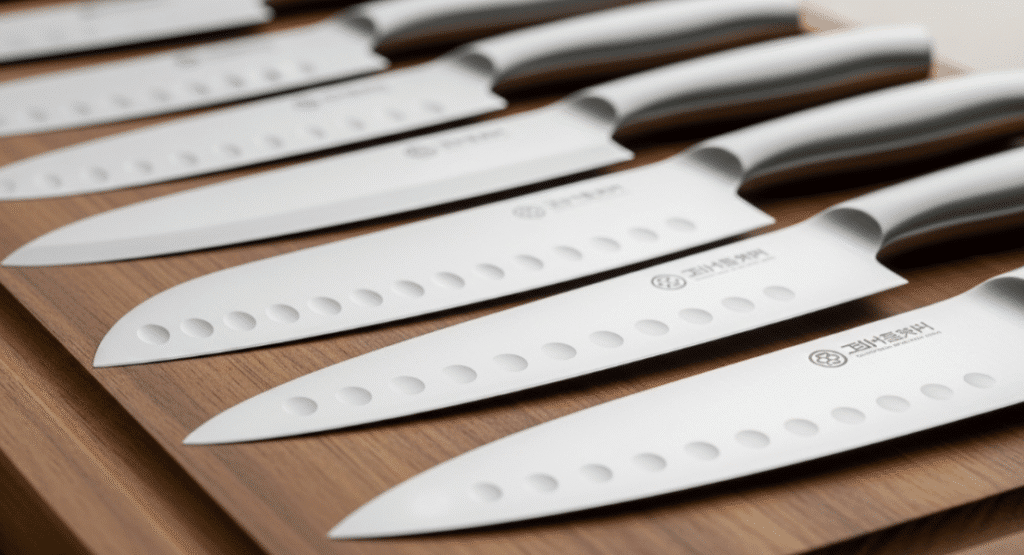
Santoku knives are amazing. They handle everything. Wide blade? Check. Flat edge? You bet. They chop. They slice. They dice. No sweat. The dimpled blade is smart. It’s called a hollow edge. Food won’t stick. That’s the point. These knives are just the right size. Five to seven inches long. Perfect for home cooks. Great for pros too. Small jobs? No problem. Big jobs? Easy. The blade angle is key. Ten to fifteen degrees. That’s sharp. Really sharp. You get precision cutting. Thin slices every time. Vegetables, meat, fish. All good. The wide blade does more. It scoops. It transfers food. Fast and accurate. That’s what you want. Edge retention? Excellent. The design gives you control. Santoku knives are top choice. They’re sharp. They’re reliable. Perfect for everyday cooking. Want speed in the kitchen? Want accuracy? Get a santoku. You won’t regret it.
Picking the Best Santoku Knives
Here’s what to look for when choosing one:
- Blade Length: Aim for 5 to 7 inches long — fits most hands and tasks.
- Blade Material: Stainless steel is low maintenance; carbon steel stays super sharp but needs hand wash and care. Forged santoku knives, crafted by master blacksmiths, offer greater durability and performance compared to stamped blades. Knives made from harder steel provide better edge retention and sharpness, making them ideal for precision cutting.
- Blade Edge: Look for a sharp edge with a slight curve for smooth cutting.
- Handle: Comfortable grip matters. Wood handles feel nice, but full tang knives with a balanced handle give better control.
- Dimpled Blade: Some santokus have dimples (hollow edge) to stop food from sticking.
Knife Materials
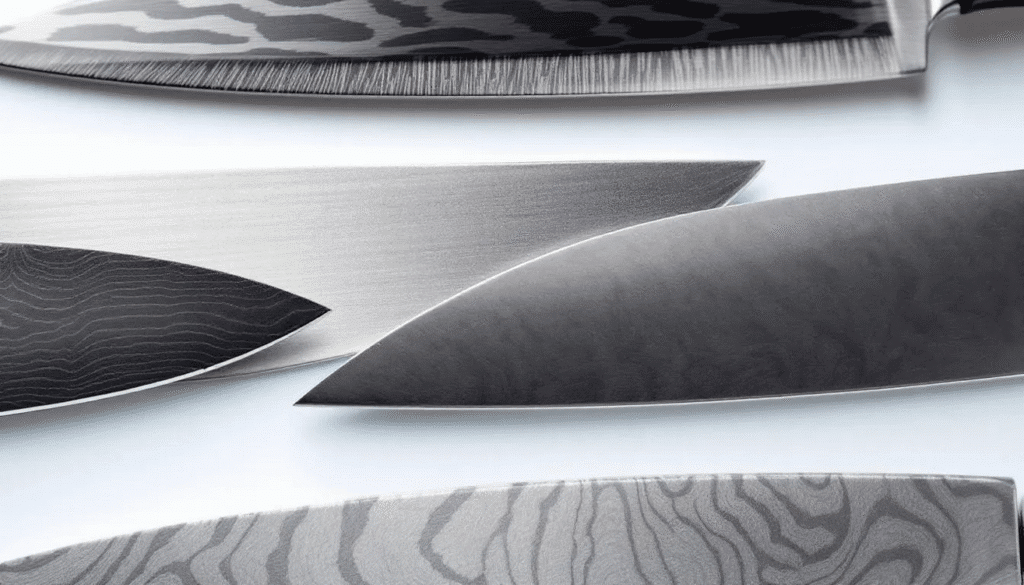
Choosing a santoku knife? The blade material matters. It matters a lot. Stainless steel is popular. Why? It resists rust. Easy care too. Perfect for busy kitchens. You don’t have much time? Stainless steel works. Carbon steel is different. It holds a sharp edge. Really sharp. Clean cuts every time. You want precision? Carbon steel delivers. But here’s the thing. Carbon steel needs care. Hand wash it. Dry it right away. Skip this? You get rust. Damascus steel is special. Layers of different metals. Added strength. Unique look too. What’s best for you? It depends. Your cutting style matters. What do you cut most? Stainless steel works great for fish. Vegetables too. Carbon steel? Perfect for meat. Really perfect. Choose wisely. A good santoku knife lasts years. Sharp edge. Reliable performance. You’ll love it.
Using Your Santoku Knife Like a Pro
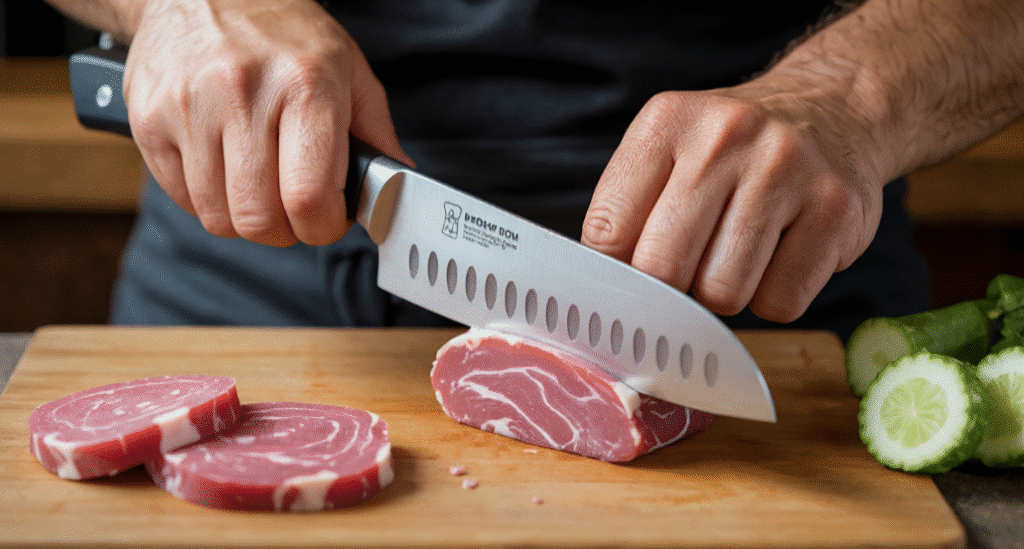
- Cut on a cutting board to keep the blade sharp and protect your counters.
- Curl your fingers on the hand holding food to keep them safe.
- Use push-cut motions for slicing and dicing — push the blade forward and down.
- Try rocking motions for chopping, but santoku works best with push cuts.
- Santoku knives are well-suited for cut meat and cut fish, as well as vegetables. They can efficiently handle slicing raw or cooked meat (without bone) and filleting or slicing fish.
- If you are left handed, look for santoku knives designed specifically for left handed use to improve comfort and cutting precision.
- Keep the blade clean and dry after use to avoid rust, especially with carbon steel.
Safety Precautions
Using a santoku knife safely? It matters. A lot. Always use a cutting board. Protect your knife. Protect your countertops. Never cut on hard surfaces. Never. When you slice or chop? Keep those fingers curled under. Keep them away from the blade. No accidental cuts. That’s the goal. Cut away from your body. Always. Keep a steady grip on the knife. Keep a steady grip on the food. Both matter. Storage is key. So important. Keep your santoku in a wooden knife block. Or use a magnetic strip. Protect that edge. Prevent accidents. After each use? Hand wash your knife. Dry it right away. Keep that blade in top shape. Avoid rust. Follow these safety tips. Keep your knife safe. Keep your fingers safe. Enjoy precision cutting. It’s that simple.
Advanced Techniques
Want to master your santoku knife? Learn some advanced tricks. They work great with this knife’s design. Try the push-cut motion. It’s really effective. Push the blade forward and down. Go through your ingredients. Don’t use that rocking motion. That’s for Western chef knives. This technique gives you clean cuts. Precise cuts. It stops the knife from sticking too. For slicing? Use smooth strokes. Keep them even. You’ll get uniform pieces. Works with vegetables. Works with meat. Works with fish. Practice makes perfect. You’ll find food prep gets faster. More efficient too. Your results? They’ll look professional. Are you a home cook? Maybe a seasoned chef? Doesn’t matter. Master the push-cut motion. Master the slicing too. Your santoku knife will reach its full potential. Every cutting task becomes easy. Like a breeze.
Caring for Your Knife and Cutting Board
- Always hand wash your santoku knife with warm, soapy water.
- Dry it right away to avoid rust or rolling of the edge.
- Sharpen regularly with a whetstone or get it sharpened professionally.
- Store it safely in a knife block or on a magnetic strip to protect the blade and your fingers.
Common Mistakes to Avoid
- Don’t press too hard — let the sharp blade do the work.
- Avoid cutting frozen foods or bones, which can chip the thin blade.
- Don’t put it in the dishwasher — that dulls the edge fast.
- Don’t leave it wet or soak it; moisture damages the steel.
Why You’ll Love a Santoku Knife
- It’s a great knife for most kitchen tasks.
- The wide blade makes it easy to scoop up chopped food.
- It stays sharp longer than many Western style chef’s knives if cared for well.
- Lightweight and balanced, so it won’t tire your hand.
Final Tips
- Practice different cutting styles to find what feels best.
- Keep your santoku sharp and dry.
- Use it for slicing fish, meat, and vegetables with ease.
- Treat it well and it’ll be your go-to cutlery for years.
Santoku knives are crafted in Japan with attention to detail and designed for everyday cooking. Whether you’re a beginner or a seasoned cook, this knife can make prepping food faster and more enjoyable. Ready to shop for one? Look for quality steel, a comfortable handle, and a blade length that fits your hand. Your kitchen will thank you!
FAQs About Santoku Knives
Can I use a santoku knife for all my kitchen cutting?
Yes! Santoku knives are great for lots of tasks like slicing veggies, dicing meat, and cutting fish. They’re handy for most jobs but avoid using them on bones or frozen stuff since that can damage the blade.
How do I keep my santoku knife sharp?
Keep it sharp by hand washing it right after use and drying it well. Sharpen it regularly with a whetstone or take it to a pro. Don’t toss it in the dishwasher—that can dull the blade fast.
What’s the best way to cut with a santoku knife?
Use a push-cut motion—push the blade straight down and forward through your food. It’s different from the rocking motion you might use with a chef’s knife, but it works great for clean, precise cuts.
Are santoku knives good for left-handed people?
Some santoku knives are made for lefties, but many are balanced enough for both hands. If you’re left-handed, look for one that’s designed for you to get the best comfort and control.
